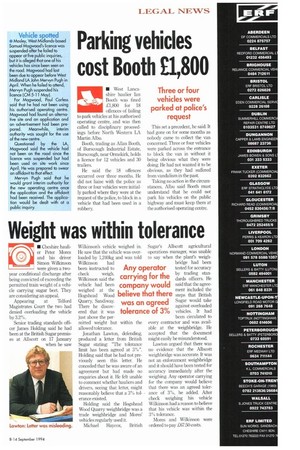Weight was within tolerance
Page 17

If you've noticed an error in this article please click here to report it so we can fix it.
• Cheshire haulier Peter Mores and his driver Simon Wilkinson were given a twoyear conditional discharge after being convicted of exceeding the permitted train weight of a vehicle carrying sugar beet. They are considering an appeal.
Appearing at Telford Magistrates Court the two had denied overloading the vehicle by 3.2%.
Senior trading standards officer James Holding said he had been at the British Sugar premises at Allscott on 17 January when he saw Wilkinson's vehicle weighed in. He saw that the vehicle was overloaded by 1,240kg and was told Wilkinson had been instructed to check weigh. Wilkinson said the vehicle had been weighed at the I logshead Wood Quarry, Sandiway. There he discovered that it was just above the permitted weight but within the allowed tolerance.
Jonathan Lawton, defending, produced a letter from British Sugar stating-. "The tolerance limit has been agreed at 3%". Holding said that he had not previously seen this letter. He conceded that he was aware of an agreement but had made no enquiries about it. He felt unable to comment whether hauliers and drivers, seeing that letter, might reasonably believe that a 3% tolerance existed.
Holding said the Hogshead Wood Quarry weighbridge was a trade weighbridge and Mores' vehicles regularly used it.
Michael Haycox, British Sugar's Allscott agricultural operations manager, was unable to say when the plant's weighbridge had been tested for accuracy by trading standards officers. He said that the agreement included the steps that British Sugar would take against overloaded vehicles. It had been circulated to every contractor and was available at the weighbridge. He accepted that the document might easily be misunderstood.
Lawton argued that there was no evidence that the Allscott weighbridge was accurate. It was not an enforcement weighbridge and it should have been tested for accuracy immediately after the weighing. Any operator carrying for the company would believe that there was an agreed tolerance of 3%, he added. After check weighing his vehicle Wilkinson had a reason to believe that his vehicle was within the 3% tolerance.
Mores and Wilkinson were ordered to pay £67.50 costs.




























































































